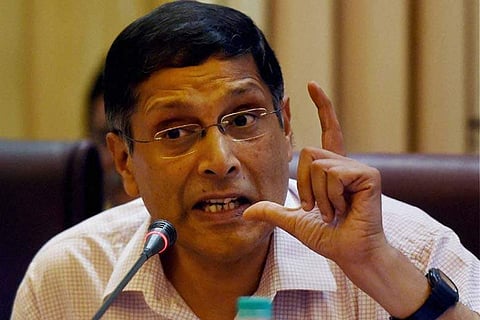

NEW DELHI: Implementing the landmark Goods and Services Tax (GST) overhauling the 70-year indirect tax regime is a major factor in the Economic Survey's projecting a GDP growth of 6.75 percent in the current fiscal, at a rate higher than that estimated by the official statistician, Chief Economic Advisor Arvind Subramanian said on Monday.
The Economic Survey 2017-18, authored by Subramanian and tabled in Parliament on Monday has listed the other factors underpinning its growth estimate as the ongoing moves to resolve the issue of non-performing assets (NPAs), or bad loans, of state-run banks, the recapitalisation plan for these banks, the recent easing of foreign direct investment rules and boosting of Indian exports amidst global recovery.
"Looking at the achievements of the past year, the launch of the transformational GST was certainly the major one," Subramanian told reporters here referring to the single national tax that replaced the earlier multiple central and state taxes from July 1.
"There were bound to be teething challenges with such a major reform and mid-course corrections were taken," he said.
The Survey said: "With a policy change of such scale, scope and complexity, the transition unsurprisingly encountered challenges of policy, law, and information technology systems, which especially affected the informal sector. Expeditious responses followed to rationalize and reduce rates, and simplify compliance burdens."
GST made 2017 the most significant year for the economy since Independence, realising the dreams of the pre-Independence nationalist bourgeoisie of a unified market in a federal system. The reform, however, came accompanied with pain for trade and industry caught off-guard by the rigours of new compliance procedures.
The new indirect tax regime has four tax slabs of 5, 12, 18 and 28 percent.
The second half of last year saw a radical reworking of the items within the four-slab tax structure by the GST Council, whereby all but 50 of over 1,200 items remained in the highest 28 percent bracket. Those retained included luxury and sin items, the cess on which goes to fund the compensation to states for the loss of revenue arising from implementing GST.
The task now is to stabilise the working of the GST, Subramanian said, adding that the working of the Council headed by the Union Finance Minister demonstrated how "cooperative federalism" is working successfully.
"The GST Council's working..from the quality and tenor of its discussions, shows how cooperative federalism can really work," the CEA said.
"It also shows the way of how reforms can be done at the state level. GST, cooperative federalism are technologies that can be used to do reforms in states in other areas (apart from indirect taxes)," he added.
Subramanian also said that analysis of the GST data revealed that there has been a 50 percent increase in the number of indirect taxpayers, besides a large increase in voluntary registrations.
Besides, data on the international exports of states also suggests a strong correlation between states' export performance and their standard of living.
Chief Economic Adviser Subramanian sounds caution on ‘alarming’ oil prices
Demonetisation led to rise of financial saving: Economic Survey
Highlights of Economic Survey 2017-18 tabled by Finance Minister Arun Jaitley in Lok Sabha
Economic Survey says India's growth rate likely to improve to 7-7.5 per cent in FY19